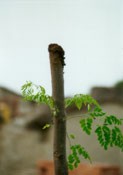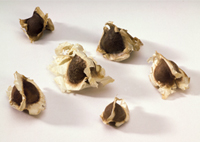Abaixo o link:
http://www.treesforlife.org/our-work/our-initiatives/moringa/how-to-grow
How to Grow the Moringa Oleifera
The Moringa tree is native to northern India, but today it is common throughout the tropical and sub-tropical regions of Asia, Africa, and Latin America.
Moringa trees grow easily from seeds or cuttings. They grow quickly even in poor soil and bloom 8 months after planting.

To grow from a cutting:
After the trees have stopped
producing fruits each year, branches
need to be cut off so that fresh
growth may take place. These
branches are excellent for growing
new trees.
- Make a cutting at least 1" (2.5cm) in diameter and at least six feet (1.8m) long.
- Dig a hole 3 ft. (1m) x 3 ft. (1m) and 3 ft. (1m) deep.
- Place cutting in this hole and fill with a mixture of soil, sand and composted manure. Pack firmly around base of the cutting. Form a slight dome or cone shape, sloping down away from the cutting. It is desirable that water not touch the stem of the new tree.
- Water generously, but do not drown the cutting in water.
In India, the custom is to put some cow dung on top of the open end of the cutting. This is an excellent way to protect the cutting from pests.

To grow from seed:
Moringa seeds have no
dormancy periods and can
be planted as soon as they
are mature.
In the ground:
It is best to plant the seeds directly where the tree is intended to grow and not transplant the seedling. The young seedlings are fragile and often cannot survive transplanting. To plant seeds directly in the ground:
- Choose an area with light and sandy soil, not heavy with clay or water-logged.
- Dig holes 1 ft (30 cm) square and 1 ft deep. Back-fill the holes with loose soil. Compost or manure will help the tree grow better, even though Moringa trees can grow in poor soils.
- Plant 3 to 5 seeds in each hole, 2 in. (5 cm) apart. Plant the seeds no deeper than three times the width of the seed (approximately ½ in. or 1.5 cm -- the size of one's thumbnail).
- Keep the soil moist enough so that the top soil will not dry and choke the emerging saplings, but it should not be too wet or else the seeds can drown and rot.
- When the saplings are four to six inches tall, keep the healthiest sapling in the ground and remove the rest. Termites and nematodes can kill a young sapling. Take measures to protect saplings from these two dangers.
Note: If the soil is heavy, dig a larger hole of up to 3 ft (90 cm) in diameter and 3 ft deep, and backfill with 1 part sand and 2 parts original soil. Added compost or manure will help.
Nenhum comentário:
Postar um comentário